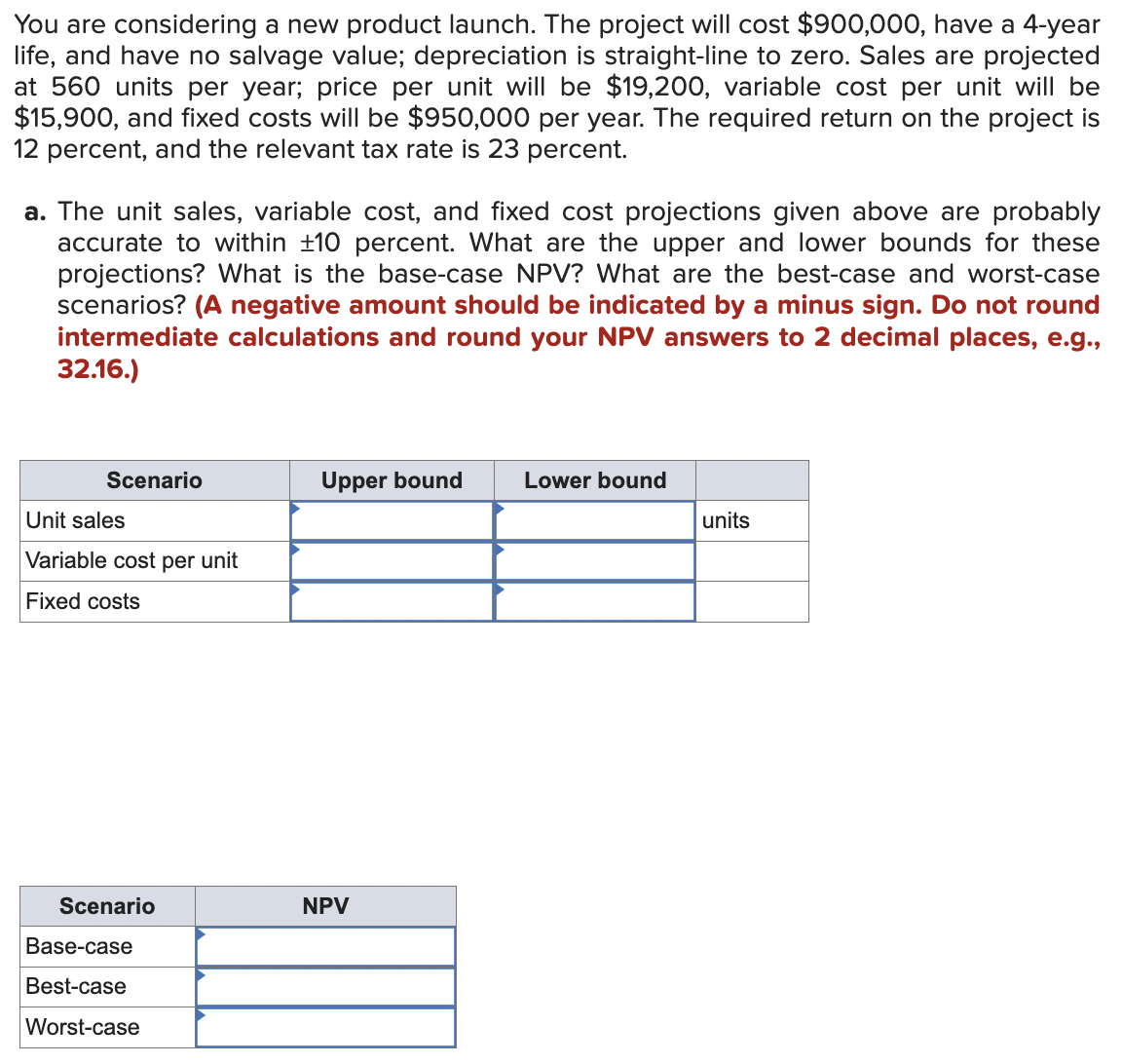a. The unit sales, variable cost, and fixed cost projections given above are probably accurate to within ±10 percent. What are the upper and lower bounds for these projections? What is the base-case NPV? What are the best-case and worst-case scenarios? (A negative amount should be indicated by a minus sign. Do not round intermediate calculations and round your NPV answers to 2 decimal places, e.g., 32.16.)
a. The unit sales, variable cost, and fixed cost projections given above are probably accurate to within ±10 percent. What are the upper and lower bounds for these projections? What is the base-case NPV? What are the best-case and worst-case scenarios? (A negative amount should be indicated by a minus sign. Do not round intermediate calculations and round your NPV answers to 2 decimal places, e.g., 32.16.)
Cornerstones of Cost Management (Cornerstones Series)
4th Edition
ISBN:9781305970663
Author:Don R. Hansen, Maryanne M. Mowen
Publisher:Don R. Hansen, Maryanne M. Mowen
Chapter19: Capital Investment
Section: Chapter Questions
Problem 10E: Roberts Company is considering an investment in equipment that is capable of producing more...
Related questions
Question

Transcribed Image Text:You are considering a new product launch. The project will cost $900,000, have a 4-year
life, and have no salvage value; depreciation is straight-line to zero. Sales are projected
at 560 units per year; price per unit will be $19,200, variable cost per unit will be
$15,900, and fixed costs will be $950,000 per year. The required return on the project is
12 percent, and the relevant tax rate is 23 percent.
a. The unit sales, variable cost, and fixed cost projections given above are probably
accurate to within ±10 percent. What are the upper and lower bounds for these
projections? What is the base-case NPV? What are the best-case and worst-case
scenarios? (A negative amount should be indicated by a minus sign. Do not round
intermediate calculations and round your NPV answers to 2 decimal places, e.g.,
32.16.)
Scenario
Unit sales
Variable cost per unit
Fixed costs
Scenario
Base-case
Best-case
Worst-case
Upper bound
NPV
Lower bound
units
Expert Solution
This question has been solved!
Explore an expertly crafted, step-by-step solution for a thorough understanding of key concepts.
This is a popular solution!
Trending now
This is a popular solution!
Step by step
Solved in 4 steps with 3 images

Recommended textbooks for you

Cornerstones of Cost Management (Cornerstones Ser…
Accounting
ISBN:
9781305970663
Author:
Don R. Hansen, Maryanne M. Mowen
Publisher:
Cengage Learning

EBK CONTEMPORARY FINANCIAL MANAGEMENT
Finance
ISBN:
9781337514835
Author:
MOYER
Publisher:
CENGAGE LEARNING - CONSIGNMENT

Intermediate Financial Management (MindTap Course…
Finance
ISBN:
9781337395083
Author:
Eugene F. Brigham, Phillip R. Daves
Publisher:
Cengage Learning

Cornerstones of Cost Management (Cornerstones Ser…
Accounting
ISBN:
9781305970663
Author:
Don R. Hansen, Maryanne M. Mowen
Publisher:
Cengage Learning

EBK CONTEMPORARY FINANCIAL MANAGEMENT
Finance
ISBN:
9781337514835
Author:
MOYER
Publisher:
CENGAGE LEARNING - CONSIGNMENT

Intermediate Financial Management (MindTap Course…
Finance
ISBN:
9781337395083
Author:
Eugene F. Brigham, Phillip R. Daves
Publisher:
Cengage Learning

Fundamentals Of Financial Management, Concise Edi…
Finance
ISBN:
9781337902571
Author:
Eugene F. Brigham, Joel F. Houston
Publisher:
Cengage Learning

Essentials of Business Analytics (MindTap Course …
Statistics
ISBN:
9781305627734
Author:
Jeffrey D. Camm, James J. Cochran, Michael J. Fry, Jeffrey W. Ohlmann, David R. Anderson
Publisher:
Cengage Learning
